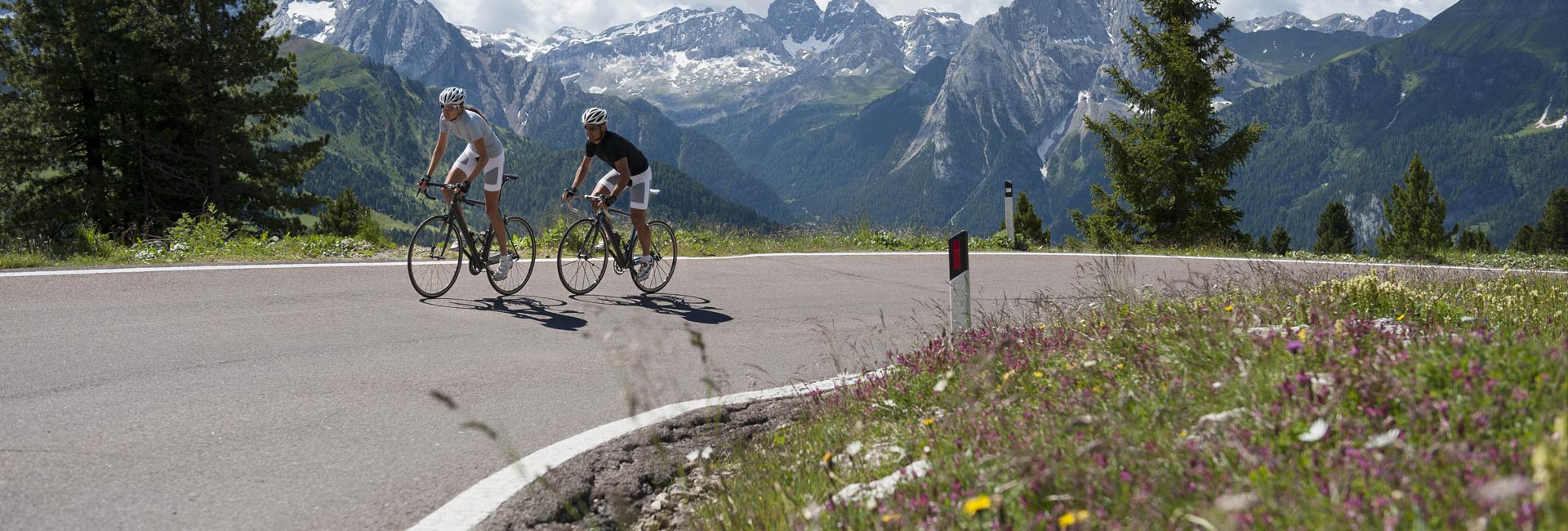Is your bicycle accumulating dust in the garage? Are you reluctantly saying “no” to long bike rides with friends and family because of knee, back, neck, wrist or forearm pain? In this blog, we’ll briefly discuss reasons why you may be having pain with cycling and things you can do to prevent discomfort while sitting in the saddle.
Knee pain while cycling
Knee pain while riding a bicycle is often related to overuse.
An overuse injury occurs when there is repetitive stress to a ligament, tendon, bone, or joint over a prolonged period in a manner that exceeds the body’s ability to recover. Unlike injuries caused by sudden trauma, such as in a crash, overuse injuries build up gradually.
The repetitive motion involved in pedaling a bike can lead to an overuse injury, specifically when riding long-distance, embarking on multiple rides without rest days in between, or increasing the intensity of the ride too quickly.
Other factors that may contribute to an overuse injury include bike fit, muscle tightness and lack of leg strength.
Bike Fit
Knee pain during or after a bicycle ride can be caused by an improper bike fit, which includes the size of the bike as related to the rider, and the position of the seat.1 A simple fix to try is simply adjusting the saddle up or down and/or forward or backward.
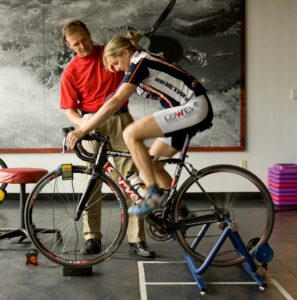
- Pain in the front of the knee and around the kneecap is typically related to patellar tendinitis or patellofemoral pain and tends to occur if your seat is too low or too far forward.3,4 The knee angle should be between about 25 to 40 degrees when the pedal is the furthest distance away from the hip.3,4 When properly positioned, it should feel like your knee is almost straight but with a slight bend.
- Pain in the back of the knee is generally related to hamstring tendinitis and can occur if the bicycle seat is too high or too far back. Try adjusting the saddle lower and/or forward in small increments – remember the 25-to-40-degree optimal range for knee angle mentioned above.3
- A seat that is too high or too low can also lead to pain on the outside of the knee, which is related to iliotibial (IT) band friction syndrome. If this is the source of your pain, you may need to be more specific with the angle of your knee in your bike fit. Try adjusting the saddle so the knee is bent to 30 to 35 degrees when at the bottom of the pedal stroke.3
- If your bike fit seems to be optimal for you, and adjusting the seat height does not alleviate your knee pain, the cleat position on your shoe or your knee alignment while pedaling may be a factor to further explore.
Strength and conditioning
Muscle tightness and strength deficits in the legs are often contributing factors to knee pain with cycling.3 Leg strength and flexibility can help ensure the muscles and joints are tolerant to loading and less susceptible to overuse injuries.1,3,4 If you’re experiencing knee pain that has you hesitating to dust off your bike, consider adding the following exercises into your routine to strengthen and condition the muscles around your knee
- Heels-elevated squat: Place a rolled-up towel or a thick book beneath your heels. Lower into a seated position until your knees reach a 90-degree angle. Hold for 10-15 seconds at the bottom of the squat before returning to standing. Repeat until you are fatigued and could only do two or three more repetitions. This move targets the quadriceps and strengthens the tendon in front of the knee as well.
- Wall sit with resistance: Place a soccer ball (or something similar in size) between the knees. Squeeze the ball between the knees as you lower to a seated position with your back against the wall. Aim for a 90-degree bend in your knees and hold for 10-15 seconds at the bottom of the squat before returning to standing. Repeat until you are fatigued and could only do two or three more repetitions. This works the inside quadricep muscle which helps with proper tracking of your knee cap.
- Bridge walkouts: Laying on your back with your knees bent, lift your hips. From this position, walk your heels out away from your buttocks and then back to the start position, then lower your hips back to the ground. Try to prevent your pelvis from tilting up and down during the exercise. Repeat until you are fatigued and could only do two or three more repetitions. This aims to strengthen your hamstrings.
- Hip flexor & quadriceps stretch: Place your rear foot on a bench or chair behind you and your front foot slightly in front of you. Lower into a lunge position using a hand for support on something near you, dropping your back knee to the floor. Use a cushy pillow to pad your knee. Hold for 30-60 seconds, as you feel a stretch throughout the front of your back leg. Be sure to stretch both legs!
Neck and back pain while cycling
If you are experiencing low back pain or neck pain while cycling, it may be due to your riding posture.
Often, neck pain is related to holding the neck in a hyperextended position (chin poked forward) for long periods. This can cause chronic tightness in the neck muscles, which can lead to pain and discomfort.5
Lower back pain while riding is typically linked to the lumbar spine being in a flexed position for a prolonged period. Being in a flexed posture for long periods can lead to issues such as disc irritation or overstretching of the muscles and ligaments around the spine, which can then lead to strains/sprains.
Bike Fit
Both of these pain points can be addressed by assessing your bike fit to ensure proper riding posture. If your handlebars are too low, you may be hunching over and reaching too far forward during your ride. Try raising the handlebars or checking the seat height. You may also consider investing in upright handlebars.2,3 Additionally, tilting the saddle forward encourages better contact between your sit bones and the bike seat, thus reducing flexed posture.3,5
Strength/Conditioning
Neck and back pain while biking may also be related to tightness in other muscles and joints, which can cause the lower back or neck to take on a bigger load than they are normally exposed to.3 If you want to optimize energy expended while cycling, you need enough flexibility in your legs to circle the cranks, good core control for energy transfer, and proper hip and back posture to improve muscular contribution from the hips.3
Lack of hamstring mobility can result in excessive lateral pelvis rocking which puts stress on the lower back.3 Lack of hip flexor mobility limits motion of the upper lumbar spine and forces stress through the lumbosacral junction (where the spinal column meets the pelvis).3 Stretching exercises that target the hamstrings and hip flexors can be a game changer for preventing pain while cycling.
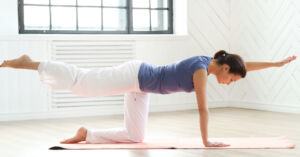
Adding core strengthening moves — such as dead bugs, elbow planks with leg lifts and bird dogs — to increase stability in the saddle is another great option to increase riding efficiency.
Without core strength, the body often uses other muscles to compensate, which can lead to pain in a variety of areas, including the neck and back.
Giving yourself a break during long rides, or taking advantage of short pauses during a ride, can also be a great way to avoid post-ride pain. If you find yourself at a rest stop or a stop light, take a few seconds to do some shoulder shrugs, back extension stretches, and shoulder blade squeezes.
Finally, foam rolling can be a great way to find relief for back pain after a bike ride.
Wrist or forearm pain while cycling
Two of the most common wrist injuries cyclists get are carpal tunnel syndrome and handlebar palsy (also known as Guyon’s canal syndrome). Both injuries may involve tingling or numbness in the hand and/or fingers and are often related to upper body positioning and how the cyclist is gripping the handlebars.2,3,5 Wrist and forearm injuries can be prevented by keeping the elbows slightly bent, alternating where pressure is placed through the hands on the handlebars, and wearing padded bike gloves.
Bike Fit
Like with knee pain and neck/back pain, wrist and forearm pain while biking can be avoided with a proper bike fit. Having the correct size of bike frame for your height is key, while a properly positioned seat and handlebars ensure that you aren’t reaching too far forward and putting unnecessary pressure through your upper extremities.2,3,5
Elbows are big shock absorbers, so it’s important to have a slight bend in them when seated on your bike. If you lock out your elbows and your shoulders roll forward, you lose the ability to absorb some of the shock from the road.
Strength/Conditioning
It’s easy to ignore the wrists and forearms when strength training and stretching for bicycling. The focus tends to be on the legs and core. However, dedicating some time to focus on the arms from fingertips to shoulders and into the back is the best way to avoid pain and injury in this region of the body. Try some of these suggestions!
- Wrist extension and flexion stretch: Straighten one arm out in front of you and grab that hand with the other. Gently pull your hand down, keeping the arm straight and bending/stretching the wrist. Hold for 20-30 seconds, then reverse and pull the hand up and hold for 20-30 seconds. Repeat on the other arm.
- Median nerve glide: This is useful if you are getting numbness and tingling in your palm, thumb, index finger or middle finger. Begin standing upright with one elbow bent out to the side of your body, your palm facing upward as if you were holding a tray, and your head tilted away from that shoulder. Straighten your arm and tilt your head toward that shoulder at the same time, then return to the starting position and repeat. Your wrist should stay in the same position. Do 5 – 10 repetitions on each side. Stop if this increases your numbness.
- Ulnar nerve glide: This is useful if you are having numbness and tingling in your ring finger or pinky finger. Bend one arm upward at the elbow with your palm toward the side of your head and your head tilted toward the same shoulder. Straighten your arm down toward your side and tilt your head to the opposite shoulder. Then repeat. Do 5 – 10 repetitions on each side. Stop if this increases your numbness.
Work with a physical therapist
If you’re experiencing pain during or after cycling that is keeping you from enjoying the sport you love, a physical therapist can help!
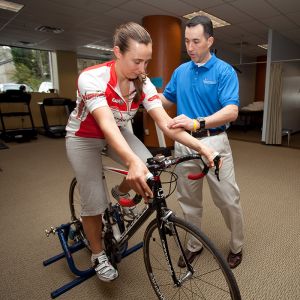
As musculoskeletal and movement experts, physical therapists are the ideal medical providers to help you get to the root of your problem. Once your PT conducts a thorough assessment and reaches a conclusion, they will create a customized plan of care for recovery as well as prevention of future issues.
In addition to working with you to improve your strength and flexibility through manual therapy and prescribed exercise, a physical therapist who specializes in bike fits will be able to assess your posture and alignment on your bike. You can browse Therapeutic Associates Physical Therapy’s Bike Fitting page to see if there is a clinician in your area who offers a professional bike fit.
General bike safety
Being able to enjoy bicycling certainly requires feeling good while riding. It is crucial, however, to also remember to follow basic safety guidelines on every biking adventure.
Wearing a well-fitting helmet can reduce your risk of head injury by 48 percent, serious head injury by 60 percent, traumatic brain injury by 53 percent and face injury by 23 percent. Statistics show that helmets reduce the total number of serious injuries or death in cyclists by 34 percent.6
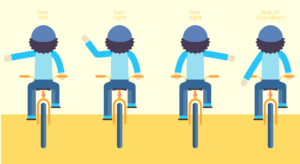
When sharing the road with cars, it is important to be aware of traffic rules. Ride on the right side of the road with traffic and not against it.6 As a rule of thumb, always assume cars don’t see you. Always double-check before taking turns, stop at stop signs, use hand signals, and wear bright clothing. If you can, limit the amount of time you spend cycling at night or in foggy conditions and make sure to utilize bike lights.6
Researching a bike route ahead of time will greatly increase your safety. Riding on designated greenways and bike trails will eliminate some stress associated with sharing the road with cars. There are many online resources and apps that can be used for route planning. Click here for a list of some of our favorite mapping and route-planning apps. Google Maps is also great and makes it very easy to find a bike route if you know your destination, but it does not give you the option to plan routes ahead of time. I personally like Komoot for route planning because it is easy to use, it can sync with my activity tracker, and it gives you turn-by-turn directions even when you’re offline.
If you or someone you know was involved in a bike crash and are having changes in vision, worsening headaches, slurred speech, dilated pupils, confusion, dizziness, behavior/mood changes, sensitivity to light, or nausea/vomiting, then it would be wise to seek immediate medical attention. These are signs of a traumatic brain injury or concussion.
References:
- Bicycling Injuries. UPMC. Published 2023. Accessed August 7, 2023. https://www.upmc.com/services/sports-medicine/for-athletes/bicycling
- Sennett B. Cycling Injuries. Orthopaedics & Physical Performance. Accessed August 7, 2023. https://www.urmc.rochester.edu/orthopaedics/sports-medicine/cycling-injuries.shtml
- Dicharry J. Clinical Bike Fit Process. MEDBRIDGE. https://taipt.medbridgeeducation.com/courses/details/jay-dicharry-clinical-bike-fit-process
- Faria, Erik & Parker, Daryl & Faria, Irvin. (2005). The Science of Cycling. Sports Medicine. 35. 285-312. 10.2165/00007256-200535040-00002.
- Here’s How You Can Prevent Injury While Cycling. Idaho Sports Medicine Institute. Published April 1, 2022. Accessed August 7, 2023. https://www.idsportsmed.com/heres-how-you-can-prevent-injury-while-cycling/
- Høye A. Bicycle helmets – To wear or not to wear? A meta-analyses of the effects of bicycle helmets on injuries. Accid Anal Prev. 2018 Aug;117:85-97. doi: 10.1016/j.aap.2018.03.026. Epub 2018 Apr 17. PMID: 29677686.
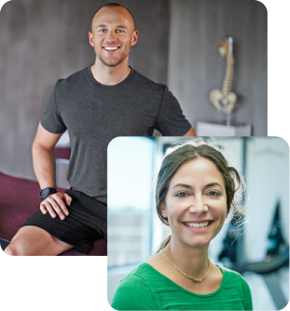
Start your physical therapy journey today.
As physical therapists, we know the importance of movement for overall health and well-being. From injury recovery to achieving optimal performance, our passion is to help every patient reach their goals and live an active, pain-free life. Get started with PT today!
